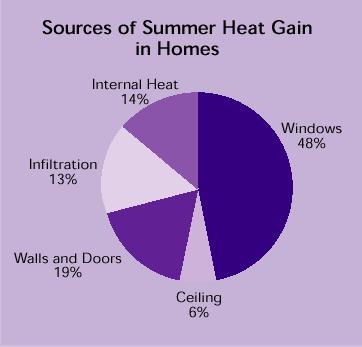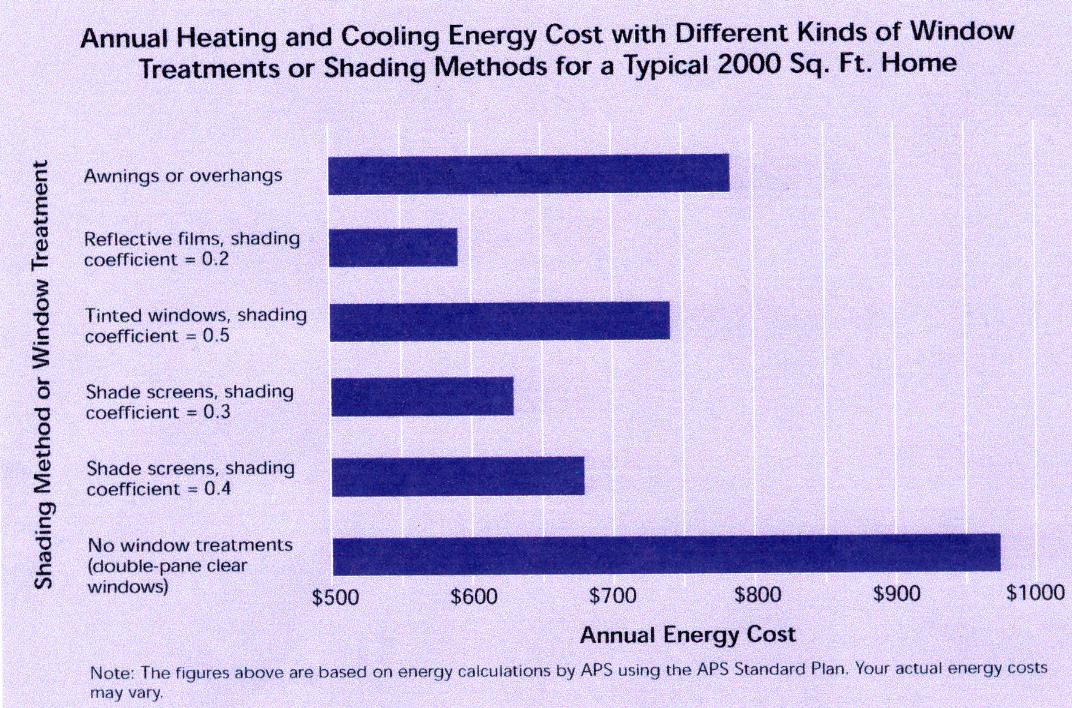Conserve Energy and Save Money With Shade Screens and Window Coverings
A simple and effective way of keeping the cool in and the hot out is to shade your windows and glass doors from the hot Arizona sun. The benefits of deflecting the sun’s heat include:
- Reduced energy consumption.
- Lower energy bills.
- Less fading of your interior furnishings.
- More consistent and comfortable inside temperature.
Our shade screens feature the following:
- Heavy duty 1 x 7/16th inch screen frames
- Painted hardware to match
- 80% and 90% Textiline fabrics
- 7 Color fabric choices
- 5 Year Manufacturers warranty
Sources of Summer Heat
As shown in the following chart, windows on a typical home in the Phoenix area account for nearly 50% of the workload placed on your air conditioning system. That’s more than the roof, walls, and attic combined! Untreated windows in the desert environment will allow about 20 times more heat into your home than an equal amount of insulated wall space. By controlling the way the sun’s energy enters your home, you can save on summer energy bills and take advantage of “free” heating in the winter.

External Shading Devices Reduce Heat Before It Penetrates Glass
According to the U.S. Department of Housing and Urban Development, stopping the sun's heat before it penetrates windows and sliding glass doors is up to seven times more effective than using interior blinds or curtains. Shade screens work best on windows with southern, western or eastern exposures. Removable shade screens allow you to take advantage of passive solar heat gain in the winter.
Blinds and Draperies Reduce Heat After It Penetrates Glass
Interior shades in your home are also very effective at blocking the sun's heat. Interior window coverings, such as blinds, shades and draperies, reduce solar heat most effectively if the surface facing the glass is a reflective color like white.
Reflective Films
Reflective film, which is applied directly to the inside of your window, is the most effective interior method of blocking solar heat. It can be as effective as external shade screens. Reflective film works best on your east and west windows. Since the film is permanently applied, it is not recommended on south-facing windows because it will prevent passive solar heat gain in the winter.
Other Helpful Hints for Keeping the Sun Out and Your Home Cooler
Installing awnings over your southern windows will provide shade in the summer without blocking the heat of the low winter sun. Planting deciduous trees (those that drop their leaves in the winter) and shrubs on the east, south and west sides of your home will also reduce the amount of summer heat that enters your home. Deciduous trees also allow the sun to warm your home in the winter. If you are building a new home or remodeling an existing home, you can design window shades and overhangs that will totally shade the windows in the middle of the summer when the sun is high in the sky, yet allow the sun’s rays to enter the window in the winter when the sun is lower.
How Much Can You Save on Cooling Your Home with Different Window Treatments and Shade Techniques?
Both new and existing homes can benefit from window treatments that control the sun’s heat. The following chart compares the benefits of different window treatments and shading techniques for a typical Phoenix area home. Not only do you save money each month on your energy bills and enjoy a more comfortable home, but you can also save on the installed cost of a new air conditioning unit. You could reduce the size of your air conditioning unit by 1/2 to 1 ton with properly applied window shading techniques. The lower cost unit means more money to spend on other amenities … without sacrificing comfort!

